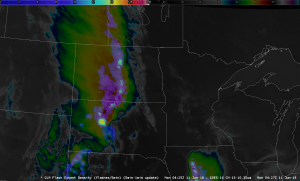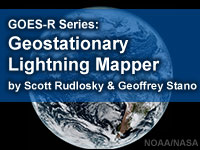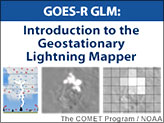Training - Geostationary Lightning Mapper
GLM Training Resources
Updated Training Documents (2020/2021) |
|||||
|
|
|||||
|
Full Disk Gridded Products Download: Quick Guide (pdf / ppt) - Quick Brief (mp4) Publish Date: 2020-11-12 Authors: Rudlosky (NESDIS/STAR), Patton (UMD/CISESS) Description: This GLM quick guide (QG) provides background to accompany the transition to full disk (FD) gridded products. The document first illustrates the spatial coverage and performance variability of the GOES-16 (East) and GOES-17 (West) GLMs. Example imagery is then shown to highlight applications of the FD gridded GLM products. |
|||||
|
|
|||||
|
Minimum Flash Area Download: Quick Guide (pdf / ppt) - Quick Brief (mp4) Publish Date: 2020-12-07 Authors: Rudlosky (NESDIS/STAR), Patton (UMD/CISESS) Description: This GLM quick guide (QG) introduces the Minimum Flash Area (MFA) product and describes its applicability. The document illustrates the additional context MFA provides beyond FED, which helps to identify features of interest (e.g., strengthening storm cores, spatial extent of large flashes, and the evolution of anvil/stratiform regions). Example use cases from the Hazardous Weather Testbed (HWT) are shown along with annotated imagery. |
|||||
|
|
|||||
|
Full Disk Data Quality Download: Quick Guide (pdf / ppt) - Quick Brief (mp4) Publish Date: 2020-12-08 Authors: Rudlosky (NESDIS/STAR), Patton (UMD/CISESS) Description: Understanding GLM performance variability is key to confidently applying these data. This GLM quick guide (QG) describes important data quality issues that may be encountered with the full disk (FD) gridded products. The document describes the present GLM performance variability, efforts toward further improving performance, and the main sources of false GLM flashes. Since most false GLM flashes occur in common locations at predictable times, knowledge of the types of GLM artifacts and where/when they occur can help mitigate uncertainties while applying these data. |
|||||
|
|
|||||
Earlier Training Documents (2018-2019) |
|||||
|
|
|||||
|
Definitions and Detection Methods Download: Quick Guide (pdf) - Quick Brief (mp4) or (html - CLC for quiz/credit) Publish Date: 2018-06-11 (Quick Guide updated 2019-05-08) Author: Rudlosky (NESDIS/STAR) Description: This Geostationary Lightning Mapper (GLM) quick brief describes the GLM detection methods and defines the Level 2 data product. The audience is shown how optical lightning observations are captured, filtered, and combined into a Level 2 product. GLM events, groups, and flashes are defined along with the methods used to locate them. Flash skeletons are shown to demonstrate the value of the rapid temporal updates provided by the GLM. The importance of observing and characterizing the horizontal flash structure is described in the context of quantifying this information to provide insights into convective storm mode and evolution. |
|||||
|
|
|||||
|
GLM Gridded Products Download: Quick Guide (pdf) - Quick Brief (mp4) or (html - CLC for quiz/credit) Publish Date: 2018-06-11 Author: Rudlosky (NESDIS/STAR) Description: This Geostationary Lightning Mapper (GLM) quick brief describes the creation of the GLM gridded products. The need for gridded products is described, and methods for computing the Flash Extent Density (FED) are shown. Example FED imagery is presented to demonstrate the first GLM gridded product available in AWIPS. Additional gridded products are introduced to illustrate their potential added value in the warning and forecast process. |
|||||
|
|
|||||
|
GLM Data Quality Download: Quick Guide (pdf) - Quick Brief (mp4) or (html - CLC for quiz/credit) Publish Date: 2018-06-11 (Quick Guide updated 2019-05-08) Author: Rudlosky (NESDIS/STAR) Description: This Geostationary Lightning Mapper (GLM) quick brief describes the data quality status during June 2018. The GLM is a new instrument undergoing extensive calibration and validation, which appears to be meeting its performance requirements despite the examples illustrated herein. The GLM gridded products are shown to exhibit a similar parallax effect to the Advanced Baseline Imager. Sources of false events are described, including platform disturbances, sun glint, solar intrusion, and overshoot at subarray boundaries. |
|||||
|
|
|||||
|
GLM Average Flash Area and Total Optical Energy Download: Quick Guide (pdf) - Quick Brief (mp4) or (html - CLC for quiz/credit) Publish Date: 2018-08-07 Author: Rudlosky (NESDIS/STAR) Description: This Geostationary Lightning Mapper (GLM) quick brief defines GLM average flash area (AFA) and total optical energy (TOE) and illustrates how these products complement flash extent density (FED) to enhance the GLM insights. These guides illustrate how the AFA and TOE help diagnose convective initiation and subsequent storm growth, and document their value for characterizing the convective scene. The AFA and TOE also help diagnose and understand how the optical lightning signals interact with the cloud scene. |
|||||
|
|
|||||
|
GLM Applications Download: Quick Brief (mp4) - Quick Guide (pdf) - CLC (html) Publish Date: Author: Stano (NASA/SPoRT) Description: The GLM applications overview focuses on the flash extent density product. This quick guide and quick brief demonstrate the physical connection to thunderstorm updraft strength and the flash extent density product and highlights the limitations and strengths of this product. Also, two simple examples of using these data are shown. This includes a severe weather decision support case and using the GLM flash extent density for lightning safety. |
|||||
|
|
|||||
|
GLM and Ground Based Networks Download: Quick Brief (mp4) - Quick Guide (pdf) - CLC (html) Publish Date: Author: Stano (NASA/SPoRT) Description: The GLM and ground networks quick guide and quick brief highlight the differences between GLM and the ground networks. The GLM observes lightning very differently resulting in unique capabilities, such as spatial extent observations, and issues to recognize, such as parallax. The information here will provide a basic overview of these differences and how to maximize the strengths of each observation system.
|
|||||
|
|
|||||
|
|
|||||
| Earliest Training Documents | |||||
|
|
|||||
|
Publish Date: 2017-10-27
|
|||||
|
Publish Date: 2014-09-05 |
|||||
Other Featured Training
WOC Severe Lessons (WDTD)
Satellite Lightning Products and Best Practices
Ground Based Lightning Products and Best Practices
FDTD Satellite Applications Webinars
Training Related Blog Posts
Lone Left-moving Supercell
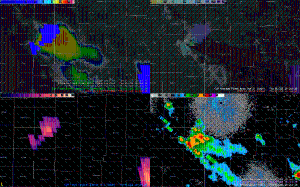
Periphery, single, small, dim flashes on central Great Plains storms
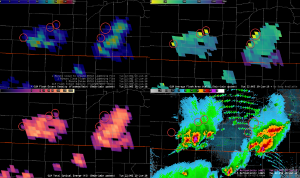
GLM Applications
